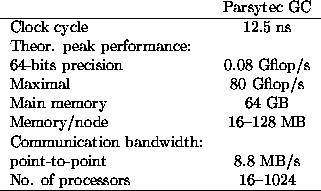
Machine type: Distributed-memory multi-processor.
Models: Parsytec Power Plus.
Operating system: Unix on host processor, Parix (GC OS,
transparent to the user).
Connection structure: Multi-stage crossbar.
Compilers: Fortran 77, ANSI C, Pascal, Modula-2.
System parameters:

The Parsytec GC Power Plus system (GC standing for Grand Challenge) is based on the IBM/Motorola MC601 processor. Initially, the CG series was planned to be built around the T9000 transputer. However, the T9000 is still not available in sufficient quantity and quality. Therefore, the MC601 was chosen to replace the T9000. It is not clear what is the maximum configuration for the Power Plus syst em. Therefore we could not give maximum performance, memory capacity, etc.
Each ``node'' (the term node not used here in the usual sense) of a GC Power Plus system contains two MC601 processors and 4 T805 transputers which are responsible for the communication. Two nodes are placed on one board, while 4 boards are interconnected with 16 C004 static routers to maintain the intercommunication within a so-called GC-cube. For every 4 nodes one redundant node is present for fault-tolerance. To complement the computing power, a parallel I/O system, the Parallel Storage System is available to aid in the handling of large-scale applications which require massive I/O.
The communication speed of the system is presently not particularly high with respect to the processor speed (although Parsytec from its PowerStone project claims that the present choice of computational versus communication capacity is optimal from the viewpoint of cost-effectiveness). There are plans to use T9000 transputers or another communication chip for communication instead of the present T805s and to replace the C004 routers by its successor, the C104. This would speed up the communication by at least a factor of 10, making the computation/communication speeds more balanced.